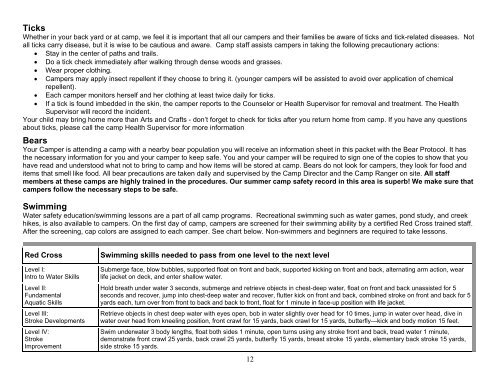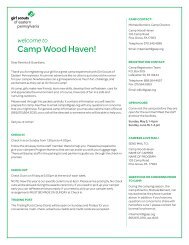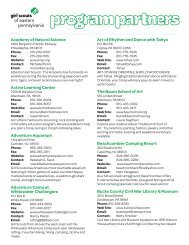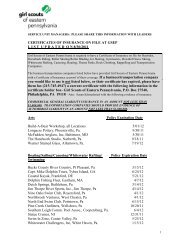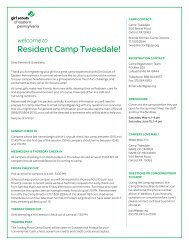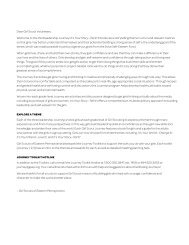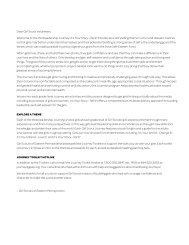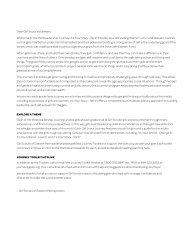Camp Director: Jodi Saul - Girl Scouts of Eastern Pennsylvania
Camp Director: Jodi Saul - Girl Scouts of Eastern Pennsylvania
Camp Director: Jodi Saul - Girl Scouts of Eastern Pennsylvania
You also want an ePaper? Increase the reach of your titles
YUMPU automatically turns print PDFs into web optimized ePapers that Google loves.
Ticks<br />
Whether in your back yard or at camp, we feel it is important that all our campers and their families be aware <strong>of</strong> ticks and tick-related diseases. Not<br />
all ticks carry disease, but it is wise to be cautious and aware. <strong>Camp</strong> staff assists campers in taking the following precautionary actions:<br />
Stay in the center <strong>of</strong> paths and trails.<br />
Do a tick check immediately after walking through dense woods and grasses.<br />
Wear proper clothing.<br />
<strong>Camp</strong>ers may apply insect repellent if they choose to bring it. (younger campers will be assisted to avoid over application <strong>of</strong> chemical<br />
repellent).<br />
<br />
<br />
Each camper monitors herself and her clothing at least twice daily for ticks.<br />
If a tick is found imbedded in the skin, the camper reports to the Counselor or Health Supervisor for removal and treatment. The Health<br />
Supervisor will record the incident.<br />
Your child may bring home more than Arts and Crafts - don’t forget to check for ticks after you return home from camp. If you have any questions<br />
about ticks, please call the camp Health Supervisor for more information<br />
Bears<br />
Your <strong>Camp</strong>er is attending a camp with a nearby bear population you will receive an information sheet in this packet with the Bear Protocol. It has<br />
the necessary information for you and your camper to keep safe. You and your camper will be required to sign one <strong>of</strong> the copies to show that you<br />
have read and understood what not to bring to camp and how items will be stored at camp. Bears do not look for campers, they look for food and<br />
items that smell like food. All bear precautions are taken daily and supervised by the <strong>Camp</strong> <strong>Director</strong> and the <strong>Camp</strong> Ranger on site. All staff<br />
members at these camps are highly trained in the procedures. Our summer camp safety record in this area is superb! We make sure that<br />
campers follow the necessary steps to be safe.<br />
Swimming<br />
Water safety education/swimming lessons are a part <strong>of</strong> all camp programs. Recreational swimming such as water games, pond study, and creek<br />
hikes, is also available to campers. On the first day <strong>of</strong> camp, campers are screened for their swimming ability by a certified Red Cross trained staff.<br />
After the screening, cap colors are assigned to each camper. See chart below. Non-swimmers and beginners are required to take lessons.<br />
Red Cross<br />
Level I:<br />
Intro to Water Skills<br />
Level II:<br />
Fundamental<br />
Aquatic Skills<br />
Level III:<br />
Stroke Developments<br />
Level IV:<br />
Stroke<br />
Improvement<br />
Swimming skills needed to pass from one level to the next level<br />
Submerge face, blow bubbles, supported float on front and back, supported kicking on front and back, alternating arm action, wear<br />
life jacket on deck, and enter shallow water.<br />
Hold breath under water 3 seconds, submerge and retrieve objects in chest-deep water, float on front and back unassisted for 5<br />
seconds and recover, jump into chest-deep water and recover, flutter kick on front and back, combined stroke on front and back for 5<br />
yards each, turn over from front to back and back to front, float for 1 minute in face-up position with life jacket.<br />
Retrieve objects in chest deep water with eyes open, bob in water slightly over head for 10 times, jump in water over head, dive in<br />
water over head from kneeling position, front crawl for 15 yards, back crawl for 15 yards, butterfly—kick and body motion 15 feet.<br />
Swim underwater 3 body lengths, float both sides 1 minute, open turns using any stroke front and back, tread water 1 minute,<br />
demonstrate front crawl 25 yards, back crawl 25 yards, butterfly 15 yards, breast stroke 15 yards, elementary back stroke 15 yards,<br />
side stroke 15 yards.<br />
12


